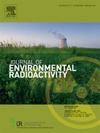用光谱和统计方法评估焊接电极的放射性水平和健康危害。
IF 2.1
3区 环境科学与生态学
Q3 ENVIRONMENTAL SCIENCES
引用次数: 0
摘要
焊接是工业发展的一个基本方面,但由于电极中存在原始放射性核素,它涉及明显的辐射危害。本研究使用带有NaI(Tl)探测器的伽马射线能谱法测量了6种市售电极中40K、238U和232Th的放射性浓度。该分析还辅以一套统计方法,包括夏皮罗-威尔克检验、方差分析、Pearson相关分析和主成分分析(PCA),以解释放射性核素分布模式、变量间关系和数据集的多元结构。结果证实,在所有类型的电极中都存在放射性同位素,表明通过吸入、皮肤接触和摄入对焊工、金属工人和公众存在潜在的健康风险。40K、238U和232Th的活性浓度分别为192.48 ~ 731.81 Bq kg-1、9.17 ~ 45.76 Bq kg-1和17.81 ~ 34.37 Bq kg-1。虽然涂有金红石和钛(不锈钢和铸表12型)的电极在吸收剂量、有效剂量和年性腺剂量方面的水平低于国际平均水平,但钍电极超过了这些全球标准。值得注意的是,所有电极类型都超过了过量终身癌症风险(ELCR)的全球阈值。主成分分析显示,超过98%的数据变异性被第一个分量捕获,证实放射性水平和相关风险指数之间存在很强的共变。为了减少健康风险,建议电极包装上包括放射性警告,并建议在通风良好或露天的环境中进行焊接。优化不同电极类型的放射性核素水平和实施防护措施对职业安全至关重要。本文章由计算机程序翻译,如有差异,请以英文原文为准。
Assessment of radioactivity levels and health hazards in welding electrodes using spectrometric and statistical methods
Welding is a fundamental aspect of industrial development, yet it involves notable radiological hazards due to the presence of primordial radionuclides in electrodes. This study measured the radioactivity concentrations of 40K, 238U, and 232Th in six types of commercially available electrodes using gamma-ray spectrometry with a NaI(Tl) detector. The analysis was complemented with a suite of statistical methods, including the Shapiro-Wilk test, ANOVA, Pearson correlation analysis, and Principal Component Analysis (PCA), to interpret patterns in radionuclide distribution, inter-variable relationships, and the multivariate structure of the dataset. The results confirmed the presence of radioactive isotopes in all electrode types, indicating potential health risks to welders, metalworkers, and the public through inhalation, skin contact, and ingestion. Activity concentrations ranged from 192.48 to 731.81 Bq kg−1 for 40K, 9.17–45.76 Bq kg−1for 238U, and 17.81–34.37 Bq kg−1 for 232Th. While electrodes coated with rutile and titanium (stainless and cast-gauge 12 types) showed levels below international averages in terms of absorbed dose, effective dose, and annual gonadal dose, thoriated electrodes exceeded these global standards. Notably, all electrode types surpassed the global threshold for excess lifetime cancer risk (ELCR). PCA revealed that over 98 % of the data variability was captured by the first component, confirming strong co-variation among radioactivity levels and associated risk indices. To reduce health risks, it is recommended that electrode packaging include radiological warnings and that welding be performed in well-ventilated or open-air environments. Optimising radionuclide levels across electrode types and implementing protective measures are essential for occupational safety.
求助全文
通过发布文献求助,成功后即可免费获取论文全文。
去求助
来源期刊

Journal of environmental radioactivity
环境科学-环境科学
CiteScore
4.70
自引率
13.00%
发文量
209
审稿时长
73 days
期刊介绍:
The Journal of Environmental Radioactivity provides a coherent international forum for publication of original research or review papers on any aspect of the occurrence of radioactivity in natural systems.
Relevant subject areas range from applications of environmental radionuclides as mechanistic or timescale tracers of natural processes to assessments of the radioecological or radiological effects of ambient radioactivity. Papers deal with naturally occurring nuclides or with those created and released by man through nuclear weapons manufacture and testing, energy production, fuel-cycle technology, etc. Reports on radioactivity in the oceans, sediments, rivers, lakes, groundwaters, soils, atmosphere and all divisions of the biosphere are welcomed, but these should not simply be of a monitoring nature unless the data are particularly innovative.
 求助内容:
求助内容: 应助结果提醒方式:
应助结果提醒方式:


